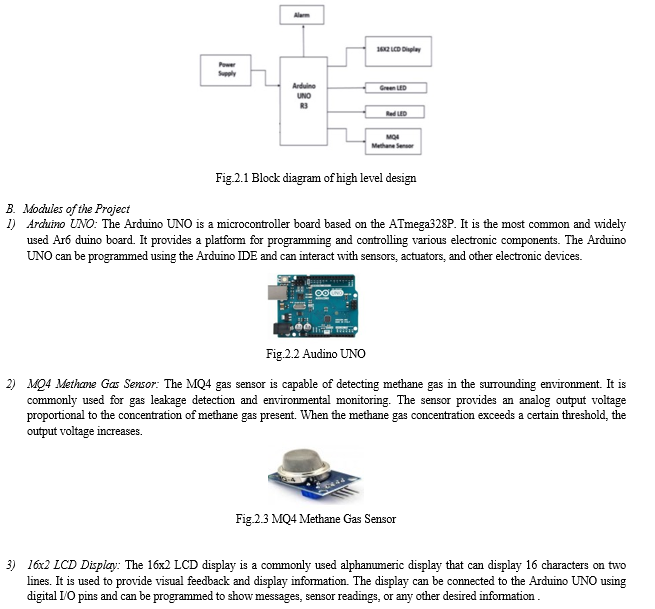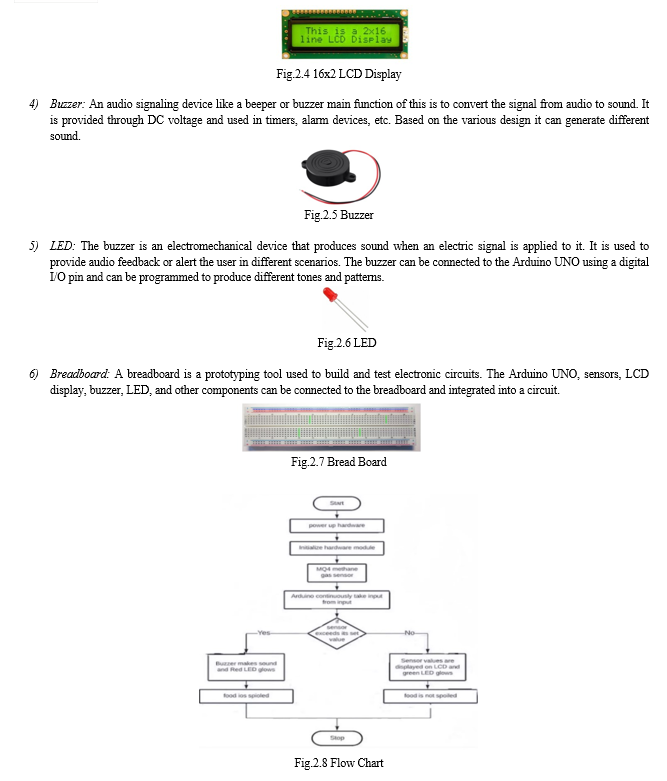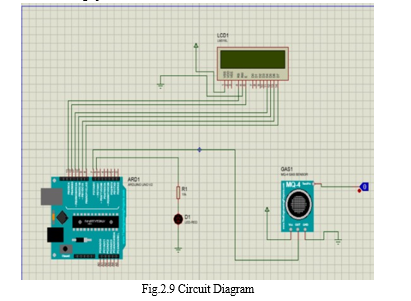Ijraset Journal For Research in Applied Science and Engineering Technology
- Home / Ijraset
- On This Page
- Abstract
- Introduction
- Conclusion
- References
- Copyright
IOT Based Food Spoilage Detector
Authors: Harshitha S, Mythreyi Manjunath H.K, Neha B.M
DOI Link: https://doi.org/10.22214/ijraset.2023.54562
Certificate: View Certificate
Abstract
With the increased reliance on technology and smartphones, there is a growing need for quick and easy solutions to daily tasks. Amough them , food is a basic and necessary factor which plays an important role in human life, To prevent the consumption of spoiled food , we have developed a food detection system using Arduino. This system uses a microcontroller to interpret inputs and activate sensors. By detecting when certain perishable items are stored in the refrigerator for too long, it can help prevent food spoilage. The system continuously senses the signals from the food and displays the methane pH value on a LCD panel, accompanied by a buzzer and LED indicator.
Introduction
I. INTRODUCTION
Food plays a vital role in human life , hence having healthy food is of utmost importance for several reasons. Firstly, a nutritious diet is essential for maintaining good overall health. It provides the necessary nutrients, vitamins, and minerals that our bodies need to function properly, enhance the immune system, and prevent various chronic diseases such as obesity, diabetes, heart disease, and certain cancers. Secondly, healthy food plays a significant role in supporting brain function and mental well-being. Studies have shown that a diet rich in fruits, vegetables, whole grains, and lean proteins can improve cognitive function, boost mood, and reduce the risk of depression and anxiety. Furthermore, healthy eating habits contribute to maintaining a healthy weight. A balanced diet, coupled with regular physical activity, can help prevent obesity, which is a growing global health concern. Being overweight or obese increases the risk of several health problems, including diabetes, high blood pressure, and cardiovascular diseases. Having healthy food also promotes sustainable agriculture and the preservation of natural resources. A diet that focuses on plant-based foods, locally sourced and organic products, reduces the environmental impact associated with intensive livestock farming, excessive use of pesticides, and deforestation. It supports a more sustainable and ecofriendly food system that works towards mitigating climate change and preserving biodiversity. Food spoilage is a global concern that impacts the environment, economy, and public health. According to the Food and Agriculture 1 Organization (FAO), roughly one-third of the food produced for human consumption every year is lost or wasted. This amounts to approximately 1.3 billion tonnes of food, valued at over 1trillion. Food spoilage occurs due to various reasons, including microbial growth, enzymatic reactions, physical damage, and exposure to heat, light, and oxygen. It not only leads to financial losses for food producers and businesses but also contributes to greenhouse gas emissions and biodiversity loss. Moreover, consuming spoiled or contaminated food can cause foodborne illnesses in humans, leading to sickness, hospitalization, or even death. Implementing a food spoilage detector becomes imperative to address these issues and minimize the impact of food spoilage. Such a system utilizes advanced technologies like sensors, data analysis, and AI to monitor and detect signs of spoilage in real-time. By accurately assessing the freshness and quality of food product.
A. Problem Statement
The issue at hand is the pervasive problem of food spoilage and wastage, which has significant negative impacts on the economy, environment, and public health. Despite existing food safety regulations and quality control measures, effectively detecting and preventing food spoilage remains a considerable challenge throughout the food supply chain. Traditional methods such as visual inspection, smelling, and relying solely on expiration dates are subjective, time-consuming, and prone to human error. Therefore, there is a pressing need for an innovative solution that leverages the Internet of Things (IoT) technology to develop a food spoilage detector capable of real-time monitoring and early detection of spoilage indicators.
B. Objectives
The primary goals of this project are to develop a sophisticated IoT-enabled device capable of accurately detecting and identifying spoiled fruits. Our aim is to minimize food waste by ensuring the device has a high level of accuracy in detecting spoilage, thereby reducing unnecessary disposal of still edible produce. To achieve this, we plan to incorporate cutting-edge sensors, including methane sensors for measuring alcohol content and CH4 gas, to effectively determine the state of the food item.
Additionally, we seek to create a comprehensive system that can detect the earliest signs of spoilage, such as odors, enabling prompt removal of the affected product from the supply chain to prevent widespread contamination.
II. LITERATURE SURVEY
The following is a literature survey on IoT-based food spoilage detectors.
- Ravi Chander, P.A. Lovina, and G. Shiva Kumari( April 2020) conducted research on a Food Quality Monitoring System that utilizes Arduino technology. This system is highly beneficial for food stores as it allows for the deployment of quality monitoring devices. These devices are designed to keep a close watch on the various environmental factors that can contribute to the decay of food. By monitoring factors such as temperature, humidity, alcohol content, and exposure to light, the system can detect potential issues with food quality.The Food Spoilage Detection system is based on the Arduino UNO prototyping board, which is widely recognized and used for its versatility. To monitor temperature and humidity, the system utilizes the DHT-11 sensor. Additionally, the system detects alcohol content using the MQ4 sensor and measures exposure to light with the LDR sensor. By connecting the Arduino board to an ESP8266 Wi-Fi Modem, the system can transmit the measured sensor data to an IoT platform via Wi-Fi. To provide immediate feedback and visibility of the sensor data, the system also displays the information on a character LCD connected to the Arduino UNO. The logged and monitored sensor data is sent to an embedded spot IoT platform, which offers a comprehensive solution for data management and analysis.[1]
- Suruchi Parmar, Tejawini Manke, Neha badhan, Prasad Borase , Prof. N.S.Ujgare Studied on the topic “An efficient system to detect freshness and quality of food”. They mainly focused on two specific aspects. Firstly, they investigated the ethanol levels in banana samples as an indicator of ripeness and decay. They found that as bananas ripened, the amount of ethanol produced increased over time. By utilizing an MQ3 sensor, they were able to accurately detect the decay process in the fruit. Additionally, the team explored a real-time milk monitoring system. They analyzed the pH level of milk samples to determine whether they were spoiled or still suitable for consumption. By monitoring the pH level, they were able to detect any changes that would indicate milk spoilage, ensuring the freshness and safety of the product. Overall, their research provides valuable insights into developing efficient systems for monitoring food freshness and quality. By utilizing sensors and analyzing specific indicators such as ethanol levels and pH, these systems can help prevent the consumption of spoiled or unsafe food, enhancing food safety and consumer satisfaction.[2]
- The study titled "EFresh - A Device to Detect Food Freshness," conducted by Naveed Shahzad and Usman Khalid, explores the use of biosensors and electrical sensors to determine the freshness of various food items. The researchers developed a smart system capable of detecting the freshness of farm produce, meat, and fruits. To accomplish this, they incorporated a hydrogen ion concentration device, a moisture sensor, and a gas sensor into the device. By utilizing these sensors, the device can accurately assess the freshness of food items, providing users with clear indications on whether the food is still suitable for consumption or should be discarded. To enhance the usability of the system, the researchers also developed an Android application that allows users to select the type of food they want to test. This innovative approach to food freshness detection offers a practical solution for individuals looking to ensure the quality of their food before consumption. With the ability to detect freshness indicators such as hydrogen ion concentration, moisture levels, and gas emissions, this device empowers users to make informed decisions about the safety and quality of the food they consume. Ultimately, this technology has the potential to reduce food wastage and enhance overall food safety in households and other food-related settings.[3]
- In their study titled "The Vegetable Freshness Monitoring System Using RFID with Oxygen and Carbon Dioxide Sensor," Ki Hwan Eom and Min Chul Kim(2012) propose a system that utilizes radio frequency identification (RFID) technology in conjunction with oxygen and carbon dioxide sensors to monitor the freshness of vegetables. The authors demonstrate that freshness can be determined by considering various factors such as wetness, temperature, oxygen, and carbon dioxide. Specifically, their focus lies on the concentrations of oxygen and carbon dioxide, as these gases are closely related to freshness and significantly impact the quality of food.To implement the system, a gas observation device is employed to measure the levels of oxygen and carbon dioxide. This device is then connected to an RFID tag, enabling easy management and tracking. By using this combined system, the freshness of vegetables can be precisely calculated. The RFID technology enhances efficiency and convenience in monitoring and managing the freshness of vegetables, allowing for timely intervention and appropriate handling to maintain product quality.The proposed freshness monitoring system offers a valuable solution for ensuring the quality and longevity of vegetables, reducing food waste, and enhancing consumer satisfaction. By accurately assessing the concentrations of oxygen and carbon dioxide, this system provides valuable information regarding the freshness of vegetables, enabling informed decisions on their usage and disposal. Overall, this technology contributes to the improvement of food freshness management in various settings, promoting food safety and reducing economic losses associated with food spoilage.[4]
A. Project Design
A simple and effective approach for detecting spoiled food involves using an Arduino UNO prototyping board along with gas sensors like the MQ4 sensor to detect the odorous gases emitted by spoiled food. In addition to sending the signals to the server, the detection results can also be displayed to the user through a buzzer, LED, and LCD panel that are connected to the Arduino board. This proposed system provides an efficient and user-friendly way to detect and monitor the spoilage of food using readily available components and IoT technology.


C. Implementation
To implement a food spoilage detection system, you can utilize an MQ4 sensor that specifically detects methane gases. When fruits or other food items spoil, they emit these types of gases. The MQ4 sensor is capable of detecting the concentration of methane gases and providing an analog voltage output corresponding to the concentration level. Next, you can compare the detected values from the sensor to predefined threshold values using a predetermined algorithm. This comparison will help determine whether the food is fresh or spoiled based on the concentration of methane gases. Once the comparison is made, the values are sent back to the Arduino board. The Arduino board can then display the output on an LCD panel. The display will indicate whether the food is spoiled or fresh based on the food freshness level determined by the algorithm. By following this implementation process, you can create a reliable and efficient system that detects spoiled food based on the emissions of methane gases. This can assist in maintaining food quality and reducing the risk of consuming spoiled food.

III. RESULT AND DISCUSSION
The quality of the food can be continuously monitored using sensors, and the results can be conveniently displayed on an LED display. In the event that abnormal readings are detected by any of the sensors, such as the MQ4 sensor, a food spoiling message will be displayed on the LED screen. This immediate notification allows for prompt action to be taken to prevent the consumption of spoiled food. Furthermore, users have the ability to view the sensor values on the serial monitor of the Arduino IDE. This additional feature provides real-time data and enables users to closely monitor the freshness of the food. They can easily track any variations in readings and identify potential spoilage issues. By implementing this system, users can ensure the quality and safety of their food, as well as minimize the risk of consuming spoiled items. graph on the serial plotter of Arduino IDE.
IV. FUTURE SCOPE AND RECOMMENDATIONS
The future scope for an IoT-based food spoilage detector is quite promising, as there is a growing need for smart and sustainable solutions in the food industry. Here are some potential areas of development and recommendations:
- Enhanced Accuracy: Research and development efforts should focus on increasing the accuracy of food spoilage detection. This can be achieved by incorporating advanced sensors, machine learning algorithms, and data analysis techniques to accurately identify and predict the spoilage of various types of food.
- Integration with Supply Chain Management: Integrating the food spoilage detector with the supply chain management system can help monitor the condition of perishable food items throughout the entire supply chain. This would enable proactive measures to be taken to prevent spoilage and reduce food waste.
- Cloud Connectivity: Connecting the food spoilage detector with cloud-based platforms can provide real-time monitoring and analysis of data. This would enable stakeholders, such as suppliers, retailers, and consumers, to access information about the freshness and quality of food products, making informed decisions about their purchase or consumption.
- Customized Recommendations: The IoT-based system can be further developed to provide personalized recommendations based on individual consumer preferences, dietary requirements, and nutritional needs. This would enhance the user experience, reduce food wastage, and promote healthier food choices.
- Data Analytics and Insights: Leveraging the collected data from the food spoilage detector can provide valuable insights into patterns of food spoilage, quality control measures, and necessary improvements in the supply chain. This data can be utilized to optimize production processes, minimize waste, and ensure overall food safety.
- Collaboration and Standardization: Collaboration between IoT solution providers, food manufacturers, regulators, and industry experts is essential to establish industry standards, guidelines, and protocols for the implementation of IoT-based food spoilage detection systems. This would ensure compatibility, interoperability, and trust among stakeholders.
In summary, the future of IoT-based food spoilage detectors lies in improvements in accuracy, integration with supply chain management, cloud connectivity, personalized recommendations, data analytics, and collaboration among stakeholders. These developments would not only address food waste issues but also enhance food safety and sustainability in the long run.
Conclusion
Food poisoning has been a significant contributor to various diseases, making it essential to take measures to reduce and prevent illness. One effective approach is the use of sensors to determine the freshness of household food items, such as fruits. With the help of Arduino sensors, it becomes possible to detect gas emissions that indicate food spoilage. By utilizing sensors to detect the presence of these gases, the early signs of food spoilage can be identified, leading to the prevention of consuming spoiled food. These techniques can be further expanded by incorporating additional types of gas sensors and extending the scope to various food items. This expansion would enhance the sensitivity of the detection methods and provide an even more accurate assessment of food quality. To implement such a system, a hardware device like the Mq4 Methane Sensor can be used. This sensor plays a crucial role in assessing the quality and freshness of food items. With the integration of sensor technology, households can proactively safeguard against the risks associated with consuming spoiled food, promoting better health and well-being for individuals and families.
References
[1] FOOD QUALITY MONITORING SYSTEM BY USING ARDUINO“B.Ravi Chander , P.A.Lovina ,G.Shiva Kumari Assistant Professors, Dept. of ECE, St.Martin’s Engineering college, Dhulapally(v), kompally,Secunderabad 500100 Telangana state, India. Journal of Engineering Sciences(JES) Vol 11, Issue 4 , April/ 2020. [2] An Efficient System to Detect Freshness and Quality of Food” Suruchi Parmar, Tejaswini Manke, Neha Badhan, Prasad Borase, Prof. N.S. Ujgare Student, Dept. Of Information Technology, KBT College of Engineering, Maharashtra, India Assistant Professor Dept. of Information Technology, KBT College of Engineering, Maharashtra, India. International Research Journal of Engineering and Technology (IRJET),Volume 7. [3] e Fresh – A Device to Detect Food Freshness : International Journal of Soft Computing and Engineering (IJSCE) ISSN: 2231-2307, Volume-8 Issue-3, September 2018. [4] Mr.A.Venkatesh, T.Saravanakumar, S.Vairamsrinivasan, A.Vigneshwar, M.Santhosh Kumar.\"A Food Monitoring System Based on Bluetooth Low Energy and Internet of Things\". Mr.A.Venkatesh et al. Int. Journal of Engineering Research and Application www.ijera.com ISSN: 2248-9622, Vol. 7, Issue 3, (Part -6) March 2017, pp.30-34. [5] Arduino Applied: comprehensive projects for everyday electronics by Neil Cameron [6] Sumathi MS, Thejaswini S, Pranav Kashyap, ShahinaAnjum, Shashi Shanker, Shreya GK \"IoT based project for food quality and monitoring\" International Journal on Recent and Innovation Trends in Computing and Communication ISSN: 2321-8169 Volume: 3 Issue: 5 3172 – 3174
Copyright
Copyright © 2023 Harshitha S, Mythreyi Manjunath H.K, Neha B.M. This is an open access article distributed under the Creative Commons Attribution License, which permits unrestricted use, distribution, and reproduction in any medium, provided the original work is properly cited.

Download Paper
Paper Id : IJRASET54562
Publish Date : 2023-06-30
ISSN : 2321-9653
Publisher Name : IJRASET
DOI Link : Click Here
 Submit Paper Online
Submit Paper Online

